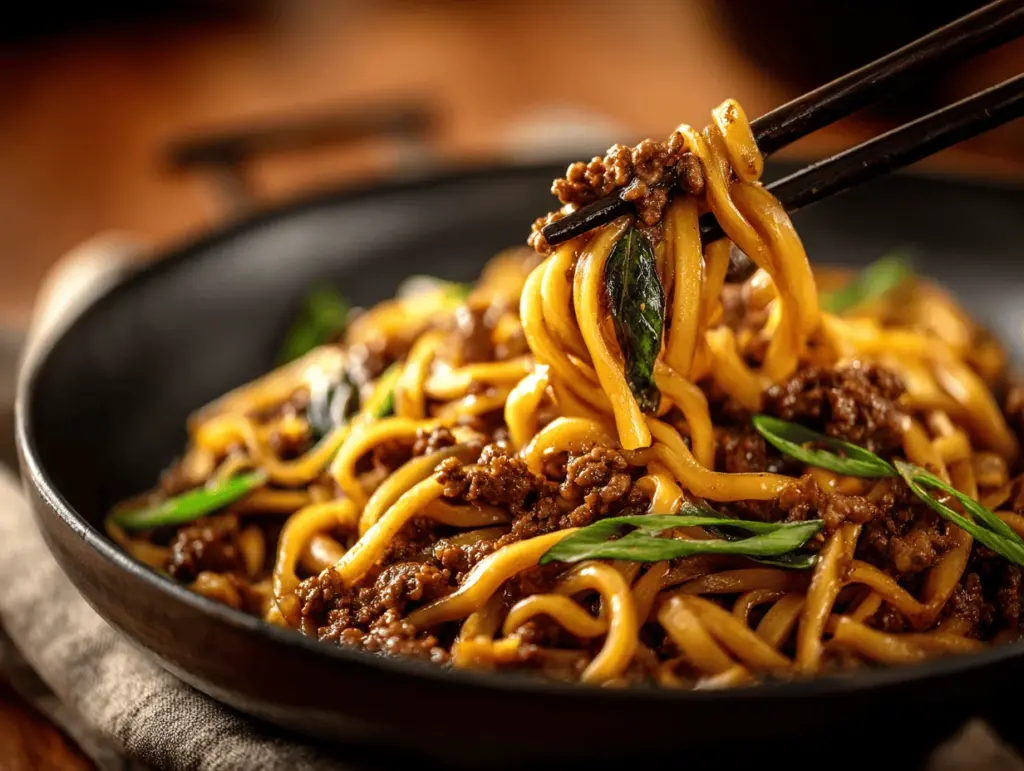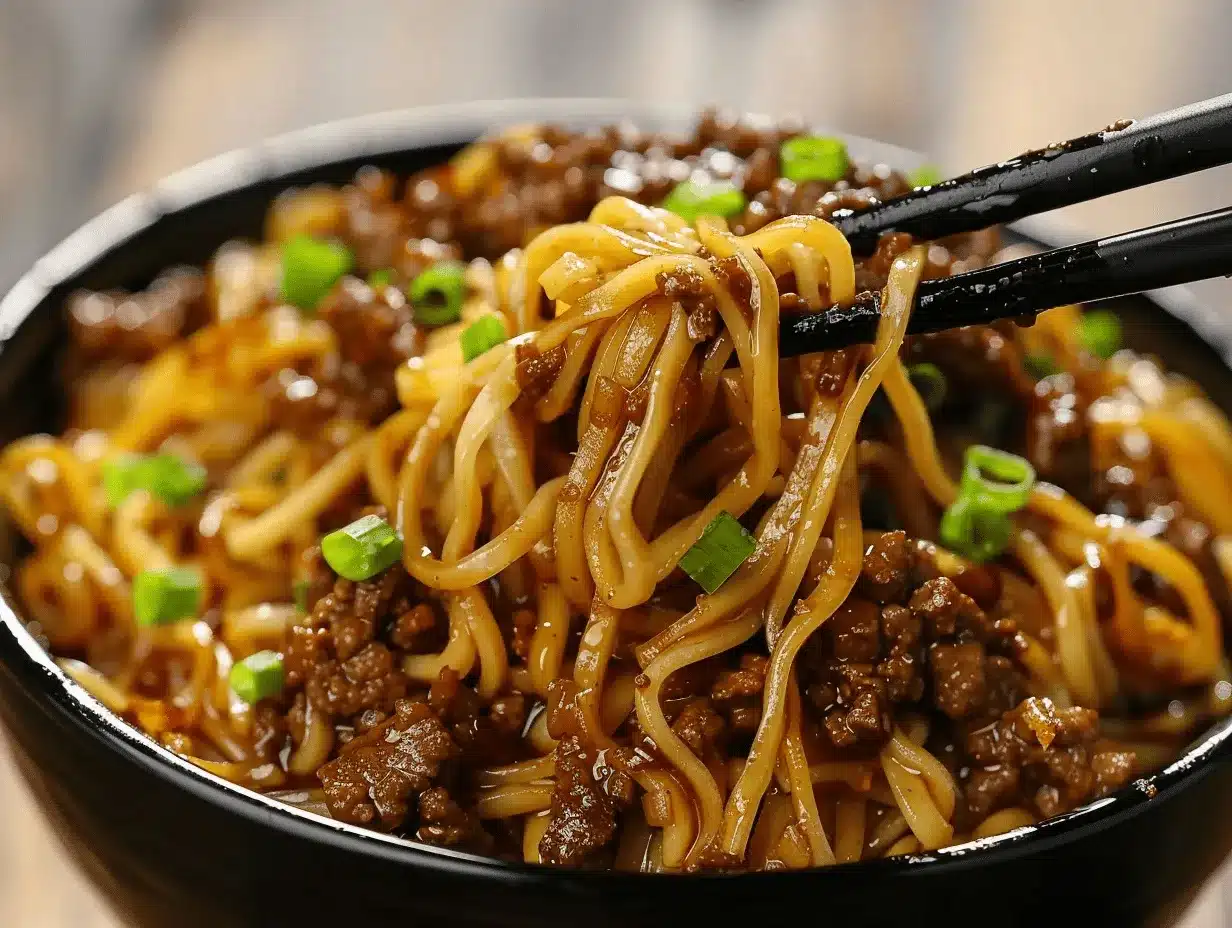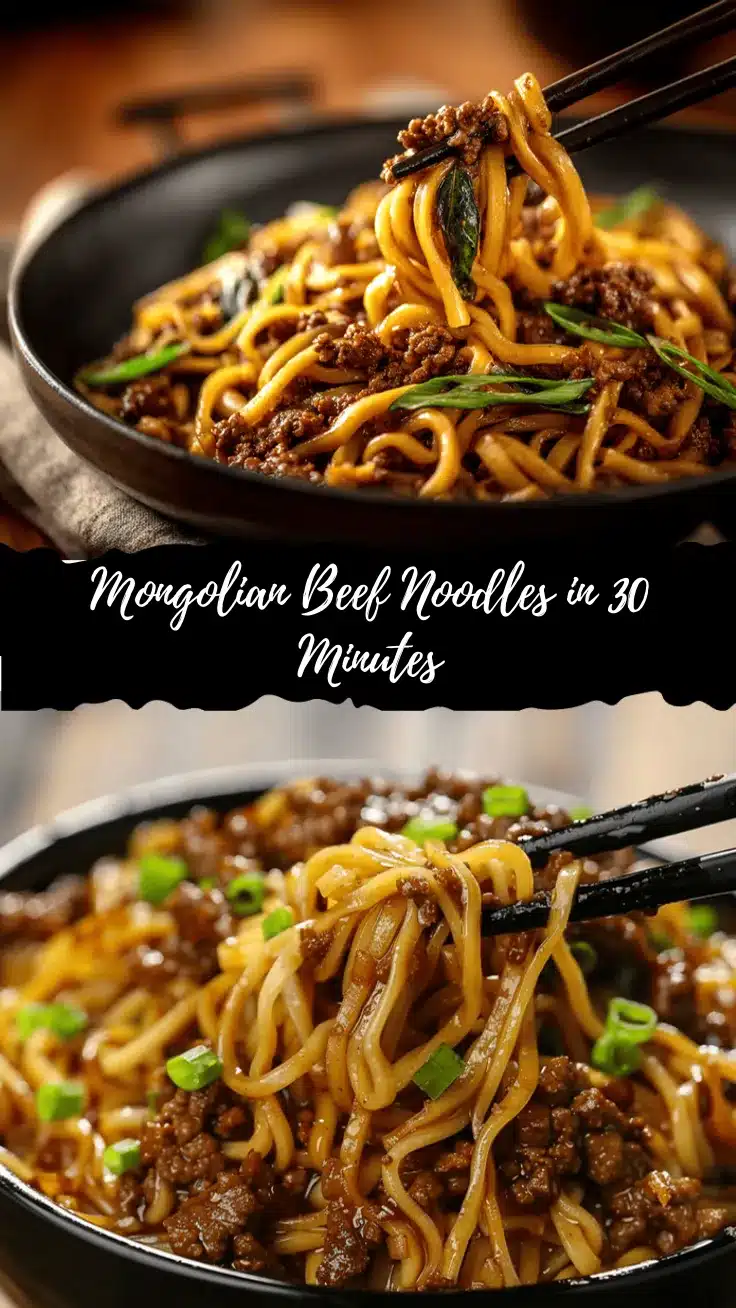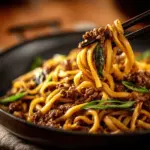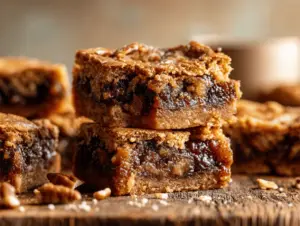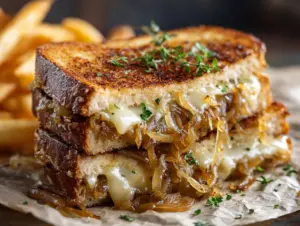The sizzle of beef hitting a hot pan, the aroma of garlic and ginger swirling in the air, and glossy noodles tangled in a sweet-savory sauce—yep, that’s what you’ll get with Mongolian Ground Beef Noodles. I can still remember the first time I whipped up this recipe after a long day, craving something bold and comforting but not wanting to wait an hour for takeout. Little did I know, this dish would become my go-to for busy weeknights and, honestly, one of my most-requested meals by friends and family.
This Mongolian ground beef noodles recipe was born from a kitchen experiment gone right. I had leftover ground beef and a half-empty box of linguine, and I was missing my favorite Chinese restaurant’s beef noodles. Instead of giving in to delivery, I decided to make a homemade version that’s just as crave-worthy and, dare I say, even better. The result? Saucy, slurpable noodles, tender beef, and that signature Mongolian flavor—ready in 30 minutes flat.
I love how approachable this recipe is. No fancy ingredients, no complicated steps—just real, everyday flavors that come together for something a little magical. Whether you’re feeding a crowd, meal-prepping for the week, or coaxing picky eaters to try something new, these Mongolian ground beef noodles have you covered. After testing this recipe at least a dozen times (tweaking the sauce, playing with different noodles, and trying every veggie under the sun), I can promise you’ll want seconds. And probably thirds, if you’re anything like me.
Why You’ll Love This Mongolian Ground Beef Noodles Recipe
- Ready in 30 Minutes: Seriously—start to finish, you’ll have dinner on the table in half an hour. Perfect for weeknights, last-minute guests, or when you just can’t wait for takeout.
- Simple, Familiar Ingredients: Everything in this recipe is pantry-friendly. There’s a good chance you already have ground beef, soy sauce, garlic, and noodles lurking in your kitchen right now.
- Ultimate Comfort Food: These noodles are equal parts cozy and crave-worthy, with a glossy, sticky Mongolian sauce that hugs every strand. It’s the kind of meal that soothes a rough day.
- Customizable for Every Eater: Whether you’re cooking for a picky kid or a spice lover, this recipe adapts. Toss in broccoli, snap peas, or carrots—or keep it classic and simple.
- Great for Meal Prep: Make a big batch and enjoy leftovers all week. The flavors somehow get even better as they sit (if you can resist eating it all at once!).
- Tested and Family-Approved: After endless tweaks and many taste tests, this is the version my family begs for. It’s consistently a hit, even with people who claim they “don’t like Asian food.”
What sets this Mongolian ground beef noodles recipe apart? The secret’s in the sauce—it’s balanced just right, not too sweet or salty, and it clings to the noodles perfectly. Plus, by using ground beef, you skip the slicing and marinating steps that typical Mongolian beef requires. It’s approachable, affordable, and honestly, the leftovers are even better the next day. This isn’t just another noodle dish. It’s the one you’ll come back to whenever you need a little joy in your bowl. I can’t wait for you to try it!
What Ingredients You Will Need
This Mongolian ground beef noodles recipe relies on a handful of familiar ingredients to deliver a punch of flavor and satisfying texture—without any fuss or specialty grocery runs. Here’s what you’ll need for noodle perfection:
- Ground Beef (1 lb / 450g) – I usually go for 85% lean for the best balance of flavor and juiciness. You can use leaner beef if you prefer.
- Noodles (8 oz / 225g) – Linguine, spaghetti, or fettuccine all work well. Rice noodles or ramen noodles are also great if you want to lean more classic. (I’ve even used udon in a pinch!)
- Garlic (4 cloves, minced) – Fresh is best for that punchy flavor. Jarred garlic works, but it’s not quite the same.
- Fresh Ginger (1 tablespoon, grated) – Don’t skip this! It adds warmth and depth. If you’re in a rush, a teaspoon of ground ginger will do, but fresh is worth it.
- Green Onions (4, sliced, plus extra for garnish) – Adds color, crunch, and a pop of freshness.
- Soy Sauce (1/3 cup / 80ml) – I use low-sodium soy sauce so it’s not too salty. Tamari or coconut aminos work for gluten-free options.
- Brown Sugar (1/4 cup / 50g) – This gives the sauce that signature Mongolian sweetness. You can use coconut sugar or honey if you want a non-refined option.
- Beef Broth (1/2 cup / 120ml) – Adds richness and helps the sauce cling to the noodles. Chicken or veggie broth works in a pinch.
- Sesame Oil (1 tablespoon) – For that irresistible nutty aroma. Toasted sesame oil is my go-to.
- Cornstarch (2 teaspoons) + Water (2 tablespoons) – This slurry thickens the sauce so it’s glossy and coats every bite.
- Crushed Red Pepper Flakes (optional, to taste) – For a little heat. My family likes it mild, but I always sneak in a pinch for myself.
- Vegetables (optional) – Broccoli florets, shredded carrots, snow peas, or bell peppers. Totally up to you! I often toss in whatever’s left in my produce drawer.
- Sesame Seeds (for garnish, optional) – A sprinkle on top makes it look restaurant-worthy.
Ingredient notes: If you’re gluten-free, use tamari in place of soy sauce and swap in your favorite GF noodles. For a lighter version, ground turkey or chicken also works—just know the flavor will be a little different. And if you want to keep things vegetarian, try crumbled tofu or a plant-based ground meat. It’s a forgiving recipe, so feel free to adapt based on what you have.
Equipment Needed
- Large Skillet or Wok – A big nonstick skillet is perfect, but if you have a wok, even better for tossing everything together quickly.
- Large Pot – For boiling noodles. I use my trusty 5-quart pot for this—it’s always the right size.
- Colander – For draining noodles. If you don’t have one, a slotted spoon works in a pinch (just be careful with hot water!).
- Wooden Spoon or Spatula – For breaking up the ground beef and stirring the sauce.
- Grater – For fresh ginger. You can use the fine side of a box grater or even a microplane.
- Measuring Cups and Spoons – So you nail the sauce every time. Eyeballing works, but I’ve learned precise measuring makes the flavor pop.
- Small Bowl – For mixing the cornstarch slurry. I’ve tried doing this right in the pan, but it never dissolves as well.
My tip: If you don’t own a wok, don’t sweat it. I’ve made this recipe dozens of times in a regular nonstick skillet. Just make sure it’s big enough for tossing everything together at the end! And if your skillet isn’t nonstick, give it a quick spritz of oil before browning the beef to help with cleanup.
How to Make Mongolian Ground Beef Noodles
-
Boil the Noodles
Bring a large pot of salted water to a boil. Add 8 oz (225g) of noodles and cook according to package directions, usually 8–10 minutes for linguine or spaghetti. Stir occasionally to prevent sticking.
Tip: Start the noodles before anything else so everything finishes at once. Reserve 1/2 cup (120ml) of pasta water before draining—this helps loosen the sauce if needed. -
Brown the Ground Beef
While the noodles cook, heat a large skillet or wok over medium-high heat. Add 1 lb (450g) ground beef. Cook, breaking it up with a wooden spoon, until browned and cooked through (about 5–7 minutes). Drain off excess fat if needed.
Warning: Don’t overcook the beef or it’ll get dry. Stop as soon as it’s no longer pink. -
Add Aromatics
Lower the heat to medium. Add 4 minced garlic cloves, 1 tablespoon grated ginger, and the white/light green parts of 4 sliced green onions. Sauté for 1–2 minutes, until fragrant.
Sensory cue: You should smell a punchy, savory aroma—don’t let the garlic brown! -
Make the Sauce
In a small bowl, whisk together 1/3 cup (80ml) soy sauce, 1/4 cup (50g) brown sugar, 1/2 cup (120ml) beef broth, and 1 tablespoon sesame oil. Pour over the cooked beef and aromatics.
Let the mixture simmer for 2–3 minutes, bubbling gently. -
Thicken the Sauce
Mix 2 teaspoons cornstarch with 2 tablespoons water to form a slurry. Stir the slurry into the skillet. Cook for another 1–2 minutes, until the sauce thickens and gets glossy.
Troubleshooting: If the sauce is too thick, add a splash of reserved pasta water or broth. Too thin? Simmer for another minute or two. -
Add Noodles & Veggies
Toss in the drained noodles and any quick-cooking vegetables (like snap peas, shredded carrots, or broccoli florets). Stir and toss for 1–2 minutes so everything heats through and gets coated in sauce.
Tip: If using heartier vegetables, steam or blanch them separately before adding. -
Finish and Serve
Sprinkle in the sliced green onion tops and a pinch of red pepper flakes if desired. Taste and adjust seasoning—add a dash more soy sauce or a sprinkle of sugar if you like it sweeter.
Serve hot, garnished with sesame seeds and extra green onions.
Personal note: I always sneak a bite straight from the pan—chef’s privilege! This dish comes together so quickly, but don’t rush the simmering step—it helps the flavors meld.
Cooking Tips & Techniques
- Prep Ingredients First: Measure and chop everything before you start. This recipe moves fast once you begin cooking, so having garlic, ginger, and green onions ready is a game-changer.
- Don’t Overcook the Noodles: Al dente is best! Overcooked noodles get mushy when tossed in the sauce. I set a timer and taste a noodle a minute before the package says they’re done.
- Use High Heat for Browning: For the best flavor, get your skillet or wok really hot before adding the beef. This gives you those little crispy bits that make the dish pop.
- Deglaze for Flavor: If you notice browned bits sticking to the pan after sautéing the beef and aromatics, don’t worry! Pouring in the sauce will loosen them up and add extra flavor.
- Balance the Sauce: If it tastes too sweet, add a splash more soy sauce or a few drops of rice vinegar. Too salty? A pinch of brown sugar (or a quick squeeze of honey) helps even it out.
- Multitask Like a Pro: Boil noodles and brown beef at the same time to save minutes. I’ll often prep the ginger and garlic while the beef is cooking.
- Personal flub: I once forgot to mix the cornstarch slurry and dumped dry cornstarch straight into the skillet—it turned lumpy fast! Always whisk it with water first for a smooth sauce.
Consistency tip: Taste as you go, especially with salt and sweetness. Every soy sauce brand is a little different. And don’t skip the green onions—they add so much freshness!
Variations & Adaptations
- Gluten-Free Mongolian Noodles: Use gluten-free tamari and swap in brown rice noodles or gluten-free spaghetti. I’ve done this for a friend with celiac, and it turns out just as delicious.
- Vegetarian/Vegan Version: Replace ground beef with crumbled firm tofu or a plant-based ground meat. Vegetable broth works great instead of beef broth. I’ve tried this with Beyond Beef, and it’s shockingly good.
- Spicy Szechuan Twist: Add 1–2 teaspoons of chili garlic sauce or Szechuan peppercorns for a bolder, tingling heat. My husband loves it this way—he claims it’s better than takeout!
- Low-Carb Adaptation: Swap regular noodles for spiralized zucchini (“zoodles”) or shirataki noodles. The sauce clings just as well, and you get that same comforting vibe with fewer carbs.
- Veggie-Packed: Toss in thinly sliced bell peppers, mushrooms, or snap peas for extra crunch and nutrition. I like to add whatever’s about to go soft in the fridge—no waste, just more flavor.
Honestly, this recipe is a blank slate. I’ve even made it with ground turkey, added crushed peanuts for crunch, or stirred in spinach at the end. Don’t be afraid to play around and make it your own!
Serving & Storage Suggestions
Serving: Mongolian ground beef noodles are best served piping hot, straight from the skillet. I like to pile them into wide bowls and top with extra green onions, toasted sesame seeds, and a drizzle of chili oil for anyone who wants extra heat. For a full meal, pair with steamed broccoli, a crisp cucumber salad, or even some homemade spring rolls.
Beverage Pairing: A cold, bubbly ginger ale or jasmine tea makes a perfect match. If you’re feeling fancy, a light lager or a not-too-sweet white wine is also lovely.
Storage: Leftovers keep well in an airtight container in the fridge for up to 4 days. The flavors get even deeper overnight. For longer storage, freeze individual portions—just know the noodles will be a bit softer after reheating.
Reheating: Microwave in 30-second bursts with a splash of water or broth to loosen the sauce. Or reheat gently in a skillet over medium-low heat. If adding extra veggies, toss them in fresh just before serving for best texture.
Flavor note: The sauce tends to absorb more into the noodles as it sits, so I sometimes add a little extra soy sauce or broth when reheating. It’s still delicious—maybe even better!
Nutritional Information & Benefits
One generous serving of Mongolian ground beef noodles (about 1/4 of the recipe) contains approximately:
- Calories: 480
- Protein: 22g
- Carbohydrates: 52g
- Fat: 18g
- Sugar: 12g
- Sodium: 900mg
Health Highlights: The ground beef brings protein and iron, while the ginger and garlic provide immune-boosting benefits. If you add extra veggies, you’ll get a vitamin boost and more fiber. You can easily make this recipe dairy-free and adapt it for gluten-free diets by using tamari and gluten-free noodles.
Allergen note: Contains gluten (unless adapted), soy, and possible sesame. Always check labels if you have food sensitivities. Personally, I love how easy it is to pack in extra vegetables and keep my family full and satisfied without a lot of fuss.
Conclusion
If you’re looking for a dinner that’s quick, comforting, and always a crowd-pleaser, Mongolian ground beef noodles are your answer. With simple ingredients and a bold, sticky-sweet sauce, this recipe delivers restaurant flavor right at home—no takeout menu needed!
What I love most? It’s endlessly adaptable. Add your favorite veggies, swap in different noodles, or crank up the heat. It’s an easy win for busy nights and picky eaters alike. After making this recipe more times than I can count, I can honestly say it never gets old.
Give it a try, and let me know how you make it your own! Leave a comment if you have questions or want to share your favorite twist. If you love it as much as I do, share the recipe with friends or save it to Pinterest for later. Here’s to more delicious, stress-free dinners—one noodle bowl at a time!
Frequently Asked Questions
Can I use a different type of ground meat?
Absolutely! Ground turkey, chicken, or even pork all work well. Just know the flavor and texture will change a bit—beef gives the most classic Mongolian taste.
What kind of noodles work best for this recipe?
Regular spaghetti, linguine, or fettuccine are great. For a more authentic feel, try rice noodles or even ramen. Use whatever you have on hand—I’ve used udon before, and it was delicious!
Is this recipe gluten-free?
It can be! Just use gluten-free noodles (like brown rice pasta or GF ramen) and swap soy sauce for tamari or coconut aminos. Always check labels to be sure.
How can I make this spicier?
Add more crushed red pepper flakes, a spoonful of chili garlic sauce, or a drizzle of chili oil at the end. I often add heat just to my own bowl since my kids prefer it mild.
Can I make this ahead of time?
Yes! Mongolian ground beef noodles reheat beautifully. Store leftovers in an airtight container in the fridge for up to 4 days, and add a splash of water or broth when reheating to keep the sauce glossy.
Pin This Recipe!
Mongolian Ground Beef Noodles
This easy Mongolian Ground Beef Noodles recipe delivers bold, sweet-savory flavor and comforting texture in just 30 minutes. Perfect for busy weeknights, it’s endlessly adaptable and always a crowd-pleaser.
- Prep Time: 10 minutes
- Cook Time: 20 minutes
- Total Time: 30 minutes
- Yield: 4 servings 1x
- Category: Main Course
- Cuisine: Asian-Inspired
Ingredients
- 1 lb (450g) ground beef (85% lean recommended)
- 8 oz (225g) noodles (linguine, spaghetti, fettuccine, rice noodles, ramen, or udon)
- 4 cloves garlic, minced
- 1 tablespoon fresh ginger, grated
- 4 green onions, sliced (plus extra for garnish)
- 1/3 cup (80ml) low-sodium soy sauce (or tamari/coconut aminos for gluten-free)
- 1/4 cup (50g) brown sugar (or coconut sugar/honey)
- 1/2 cup (120ml) beef broth (or chicken/veggie broth)
- 1 tablespoon toasted sesame oil
- 2 teaspoons cornstarch
- 2 tablespoons water (for slurry)
- Crushed red pepper flakes, to taste (optional)
- Vegetables, optional (broccoli florets, shredded carrots, snow peas, bell peppers)
- Sesame seeds, for garnish (optional)
Instructions
- Bring a large pot of salted water to a boil. Add noodles and cook according to package directions (usually 8–10 minutes for linguine or spaghetti), stirring occasionally. Reserve 1/2 cup pasta water before draining.
- While noodles cook, heat a large skillet or wok over medium-high heat. Add ground beef and cook, breaking it up with a wooden spoon, until browned and cooked through (about 5–7 minutes). Drain excess fat if needed.
- Lower heat to medium. Add minced garlic, grated ginger, and the white/light green parts of the green onions. Sauté for 1–2 minutes until fragrant.
- In a small bowl, whisk together soy sauce, brown sugar, beef broth, and sesame oil. Pour over the cooked beef and aromatics. Let simmer for 2–3 minutes.
- Mix cornstarch with water to form a slurry. Stir the slurry into the skillet and cook for another 1–2 minutes, until the sauce thickens and gets glossy.
- Add drained noodles and any quick-cooking vegetables to the skillet. Toss for 1–2 minutes until everything is heated through and coated in sauce.
- Sprinkle in green onion tops and red pepper flakes if desired. Taste and adjust seasoning. Serve hot, garnished with sesame seeds and extra green onions.
Notes
Prep all ingredients before starting, as the recipe moves quickly. For gluten-free, use tamari and gluten-free noodles. For vegetarian, substitute ground beef with crumbled tofu or plant-based ground meat and use vegetable broth. Add extra veggies for nutrition and crunch. Leftovers keep well and flavors deepen overnight. Adjust sauce balance with extra soy sauce or sugar as needed.
Nutrition
- Serving Size: About 1/4 of recipe (approx. 2 cups)
- Calories: 480
- Sugar: 12
- Sodium: 900
- Fat: 18
- Saturated Fat: 6
- Carbohydrates: 52
- Fiber: 3
- Protein: 22
Keywords: mongolian beef noodles, ground beef noodles, easy noodle dinner, 30 minute meal, asian noodles, weeknight dinner, beef stir fry, comfort food
